If you wish for a dry basement that you can either use to remodel into an entertainment area or family room or even for storage, you may want to consider waterproofing it first, but let’s be real, it can be really expensive so is basement waterproofing worth it ?and what are the types of basement waterproofing? and what is the exact budget for it?
It is important to comprehend that basement waterproofing is not a simple task. Water intrusion of any kind in the basement of your home can be catastrophic and to avoid any kind of cracks and leaks basement waterproofing seems like a wise choice.
A leaky basement is a matter of significant concern for any homeowner. it can appear to be a slight trickle or leakage but can turn out to be a warning sign that might cause deficiencies in your house so it requires instant action . If wetness and moisture were to be found in the basement area of your house, will eventually lead to an array of time-consuming and very expensive repairs, one the other hand, waterproofing your basement before such damage has already occurred will save you a lot of time and money and reassure you from any leaky basement concerns.
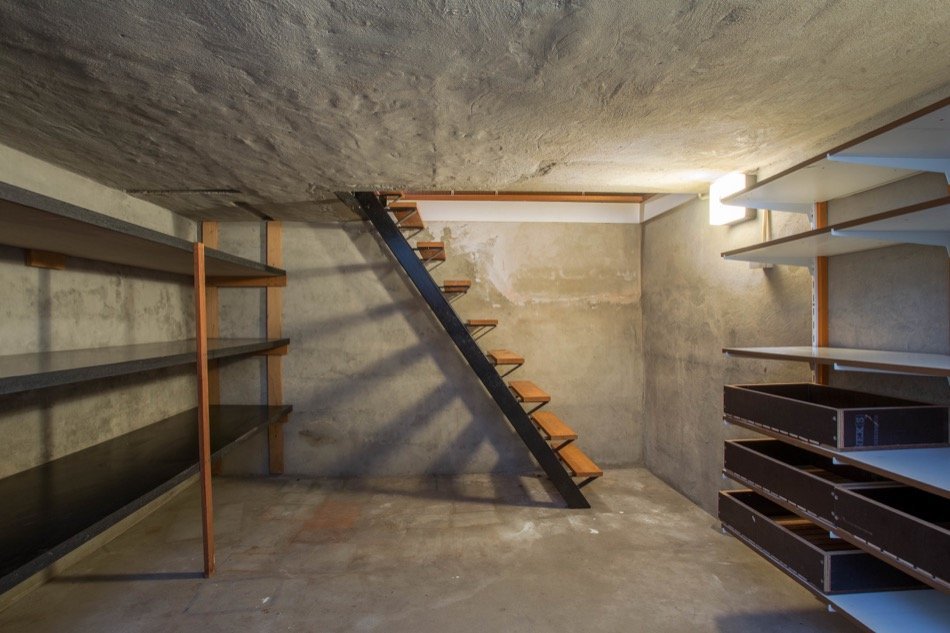
WHAT CAUSES A WET INTERIOR BASEMENT:
In order to understand the importance of maintaining your basement and keeping it dry, it is vital to know what exactly leads to moisture and leakage. Unfortunately, as homeowners, it is essential to bear in mind that water has a knack for finding its way into each and every corner of your home. Basements are particularly prone to wetness due to the nature of their construction so here are the main causes leading to basement moisture:
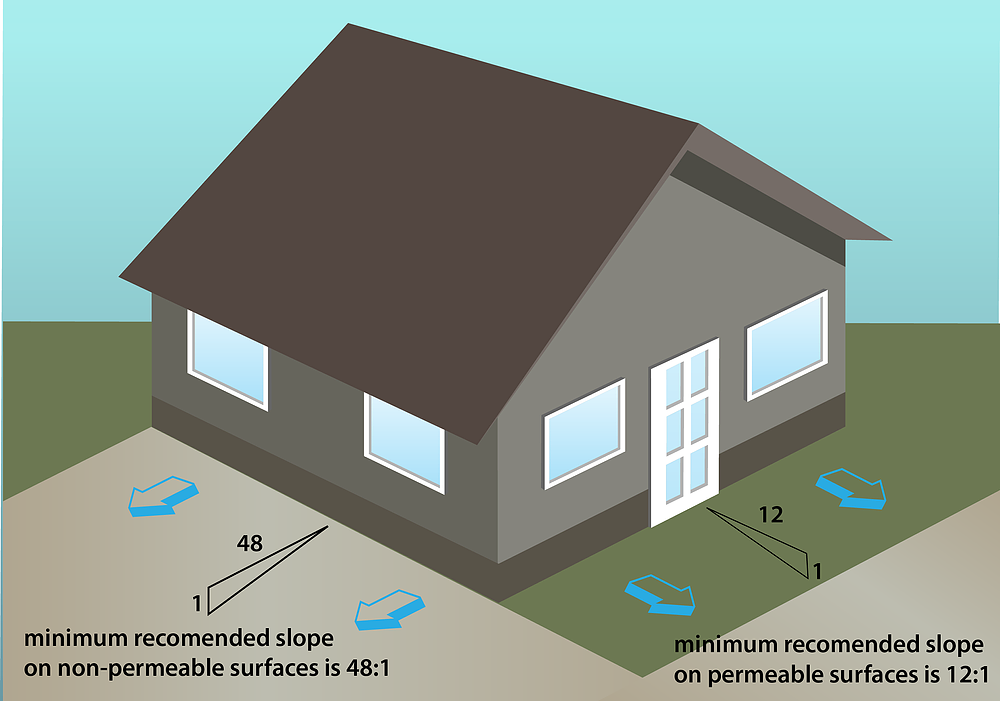
Improper Slope:
The ground near the foundation of your house outside needs to slope away from your home. The slope is not supposed to decline towards the house’s foundation. In case the slope is faulty, water accumulation occurs in the surroundings of the house. It will eventually lead to damage in the overall structure.
Improper Drainage & Soil Systems:
If the groundwater and rainwater cannot drain properly, they can leak into the basement area of your home. Poor drainage systems as well as weak soil around your house’s foundation are some of the main causes of wetness in that area. When the water flow is directed towards your house and not pushed away, it will build up in the surroundings of the foundation of your house making its way into the basement’s cold joints, holes, cracks and porous walls.
Poorly Installed & Maintained Gutters:
When properly installed, Gutters can direct rainwater to a different direction than the foundation of your home. However if poorly installed or maintained, the gutter systems can actually lead to the opposite effect. Clogged gutters, or ones that drain too close to your foundation will end up depositing water along the base of your home instead of an opposite direction. So you need to ensure that your gutters are always clean and free of debris so they keep working properly. make sure you have downspouts direct water as far away from your foundation as possible.
Condensation:
Basements are known for being notoriously moist places. Any case of condensation in your basement will eventually lead to the build up of molds and mildew, this can cause potential damage to all organic surfaces in your house especially the ones made out of sheetrock and wood.
Cracks in the Basement:
Cracks in your basement floors, walls or ceilings or even around the doors & windows tend to form a path for water flow coming from the outside. Water can reach any area of your house, especially the least resistant ones, and cracks in the basement provide a good environment for water leaks.
Hydrostatic Pressure:
Hydrostatic pressure usually occurs if water keeps accumulating around the foundation of the house. Whenever water is pushed down by the forces of gravity, it tries to escape by releasing pressure.Therefore, the water finds its way into cracks on the walls and the floor..
BASEMENT WATERPROOFING TYPES:
Now that you know how essential basement waterproofing is, you must be wondering how it is done, so we have arranged for you a list of the common ways of basement waterproofing:
DIY Waterproofing:
Exterior Waterproofing:
Interior Waterproofing:
Drainage Systems:
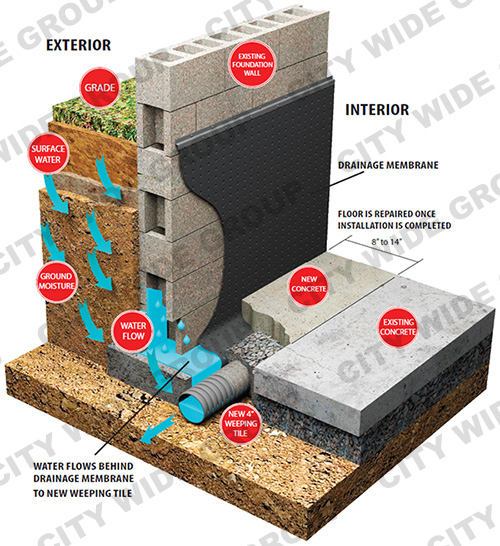
DIY Waterproofing:
homeowners can utilize a simple and quick solution at the first sign of a water leak or crack is visible in their basement. A quick and easy method for interior waterproofing can be done using coatings and sealants, along with a dehumidifier to prevent condensation in the basement area and stopping any further leaks.
Other accustomed solutions for interior basement waterproofing are done by sealing existing cracks or holes in the floors, walls, or ceilings and appropriately making them watertight. Special sealants like hydraulic cement, can be utilized to fix cracks or holes.
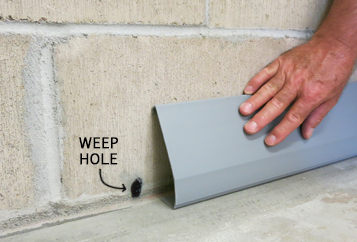
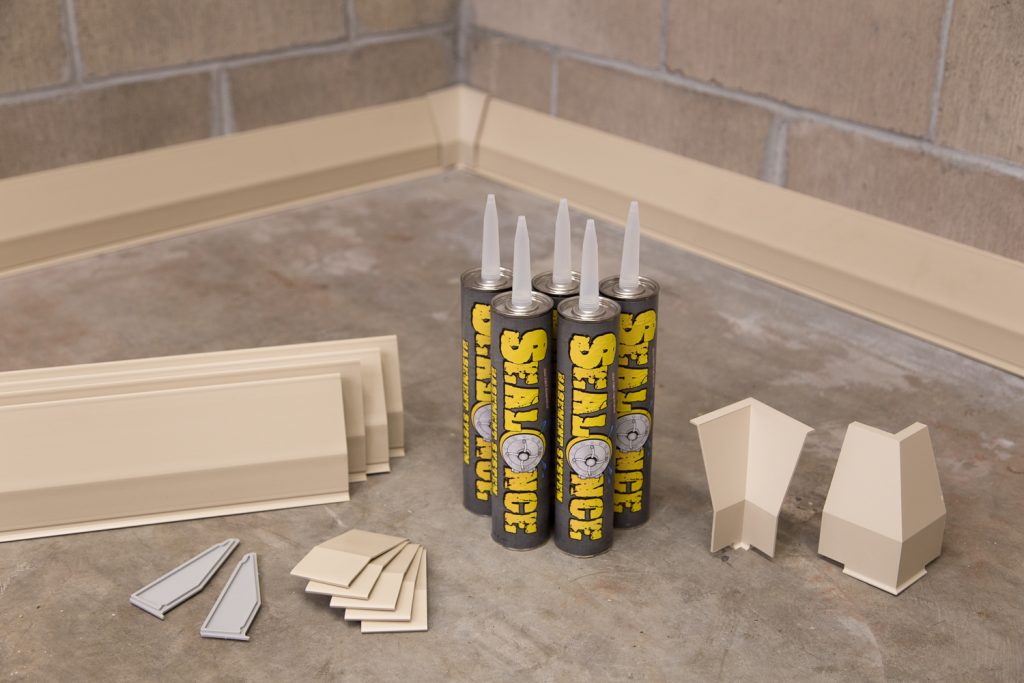
Exterior Waterproofing:
It is indispensable to make the interior of one’s basement waterproof but exterior waterproofing is impartially crucial. In the case of wet basements, most of the damage usually arises from the outside of your home. Therefore, it is essential to look at the exterior portion of the basement. This type of waterproofing calls for an expensive and very complicated approach compared to interior basement waterproofing. This procedure requires a unique skill set of laborers to help get the best results.
Exterior basement waterproofing includes excavating the soil around the foundation of your house. This is considered to be quite a labor-intensive procedure that might call for large tools & machinery. When the soil surrounding your home’s foundation has been excavated in good order, a high-quality watertight sealant is then applied to the outer walls of your basement. The sealant is a material based on polymer and has a lifespan of 25 years. but in reality, it stops being effective after 5 years of usage.
It is recommended that basement waterproofing should occur during the primary construction of the house, therefore quickly constructed homes lack the right protection to fight leaks and water intrusions. If exterior basement waterproofing is done after the original construction of the house, that will lead to a breached waterproofing material: it is the result of hydrostatic pressure changing with every rainstorm tearing down layers applied during the waterproofing which will eventually cause the loose soil surrounding the house to move up and down. It is also crucial to mention gutter systems when discussing exterior waterproofing methods.
Overall, exterior waterproofing is considered expensive and short-lived.
Interior waterproofing:
An interior basement waterproofing is nothing compared to a temporary Do It Yourself interior repair and an expensive non lasting exterior waterproofing. It is considered to be the smartest and most effective choice out of the other methods.
Picture a waterproofing system that blocks water as effectively as an exterior drainage technique without the concern of loose, soft soil around the hydrostatic zone, wearing it away. Exterior techniques tend to clog with dirt and rocks. The possibility of root intrusion and grading the foundation of the house again after 8 to 10 years is concernedly high.
An interior basement waterproofing system can handle the water flow under your floor properly by getting rid of groundwater before it reaches your floor. Other systems promoted by large franchises can stop water at almost floor level, keeping moisture out and keeping walls and floors dry. Ensure that you get a system that handles water in the right location underneath your floor. The beauty of it all is that you don’t have to lose any of your landscaping outside with a heavy and short-lived excavation project. Most interior waterproofing techniques are set and ready to function in 2 to 3 days when done correctly.
The installation of a sump pump is considered to be as crucial as the interior basement waterproofing system itself . When installed properly, it will eliminate thousands of gallons of water through a discharge pipe that give on to an outside drainage basin. Some basements don’t call for a sump pump machine when they contain drain grates located in the basement floor center. Those grates are composed of a drainage path underneath the floor that leads away from the foundation. Sometimes those grates are not sufficient to get the discharge of the groundwater found between walls and the floor.
It all comes down to who you buy your waterproofing system from. Currently, this type of basement waterproofing is unmonitored so be careful where you buy it from. First of all, you need to do thorough research before investing in one. If you want to put an end to your water problem, install a robust system that requires low to zero maintenance. If it calls for maintenance and special flooring, you will be paying for the system for as long as you live in that house so you need to invest in the right basement system for results that are worth your money.
Drainage Systems:
Drainage problems are often considered the underlying reason leading to moisture in your basement. Draining properly around your house is crucial to keep the basement dry . These drainage systems are made for directing water ( groundwater and rainwater) away from your house. There are plural different drainage techniques available to keep the water around your home in control. For starters, you should observe and examine the soil surrounding your house. Each type of soil drains in a different manner.
Make sure your house contains soil that drains quickly and does not retain moisture.Each home is unique, so make sure that the drainage around your home is functioning properly. Take a close look at the slope of the ground surrounding your foundation. It should slope in the opposite direction from your foundation, not towards it. Depending on your specific basement, it may be essential to install a sump pump to collect excess water from the inside of your house and your basement and throw it away.
BUDGET OF BASEMENT WATERPROOFING:
Now that you have everything you need to know about basement waterproofing from its types to its importance as well as the causes of leaks, you must be wondering about the budget and the costs. We have done a thorough research to give you these estimations concerning each technique below so you can invest safely .
Waterproofing gives your basement a fresh and new lease on life as well as dryness for a very long amount of time. So what is the cost of basement waterproofing? Here’s a breakdown of all the costs and fees you should be ready to pay to get your basement waterproofed.
Foundation waterproofing costs:
Foundation waterproofing is done by excavating the soil around the foundation, drainage panels are installed afterwards along with well near all the exterior walls. It is considered to be the most effective technique for clay soil, which demands flexibility to let expansion and contraction take place.
Membranes differ in pricing. Regardless of the material used , you’ll be looking at a price ranging from $5,000 to $30,000 or more, the price varies according to the size of the house.
Exterior waterproofing costs:
1) Excavation : If you live in a house with accessibility issues or limited space , you might have to excavate the exterior to be able to reach the outer portion of the basement. This cost may vary from $70 and $150 per foot, the pricing is relative to the depth.2) Window wells and drains : they help usher light inside the basement.
2) Window wells and drains can also be utilized as emergency exits and keep basement window egresses safe from floods.You’ll be looking at a bill ranging from $500-$2,000. Drains are around $400 and window wells cost approximately $950.On the other hand, an all-inclusive egress window can cost from $10,000 to $12,000.
3) Removal of standing water : If you suffer from standing water on your basement foundation, driveway, or your lawn, you need to get rid of it. You need to note that JES is not able to remove water from your driveway, the expert team will start by installing PolyRenewal instead , and that will be applied to the cracking and sinking concrete found within the driveway. That installation will cost you $1,400 between $5,500 , the price varies depending on the extent of the damage and the area in question. The fee of the replacement of concrete costs around $22 per square foot.
4) Gutters and downspouts installation: Gutters and downspouts have the role of channeling water away from the walls and direct them to your sewer line, on average, downspouts can cost $19 per foot.
5) Exterior weeping tiles: They are pipes made out of plastic and have perforation. Exterior weeping tiles assemble water before it breaches the wall. Installing them calls for excavation. The bill for this installation is $100 per foot for each pipe.
Interior waterproofing costs:
The average cost of waterproofing a 1,200 square foot basement is around $15,000. The exact cost of your basement depends on its size as well as the material and the machinery utilized to obtain the final product.
Typical waterproofing projects begin with a thorough inspection . Local contractors will usually do this examination for free and will also advise you on the next steps to make.
A vapor barrier: it is an effective tool for preventing water leaks. While it is widely used to crawl area encapsulations, it also has other applications running in the basement. You need to hire a professional to help you with the work, and contractors can charge you anywhere from $ 1,500- $ 3,000 for full installation. The cost depends on the size of the basement and the quality / size of the vapor barrier sheet.
Other costs you may want to include:
Sump pump installation: a new sump pump installation could cost between $1,600 and $3,000 , all according to the model.
A basement dehumidifier for big spaces costs between $2,200 and $2,600.
